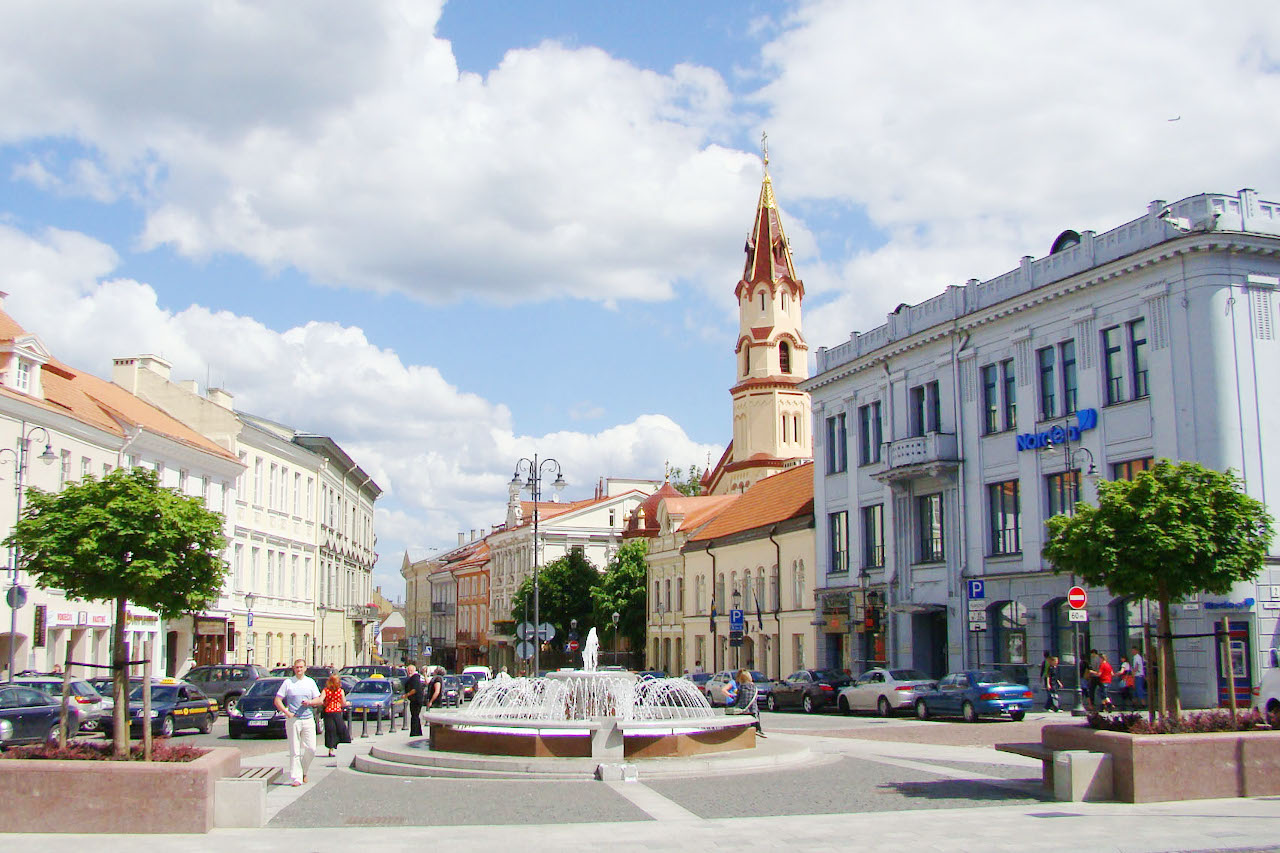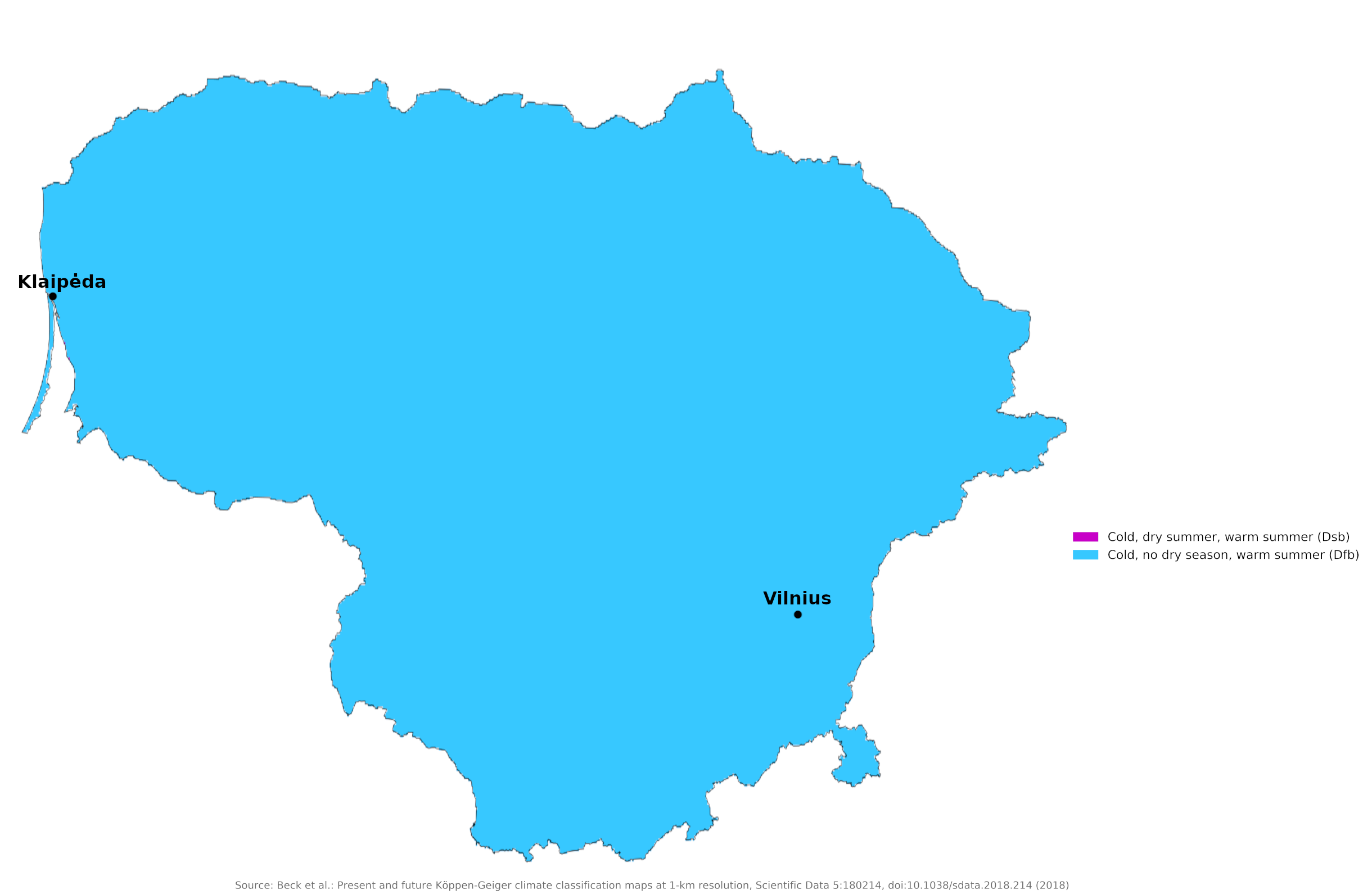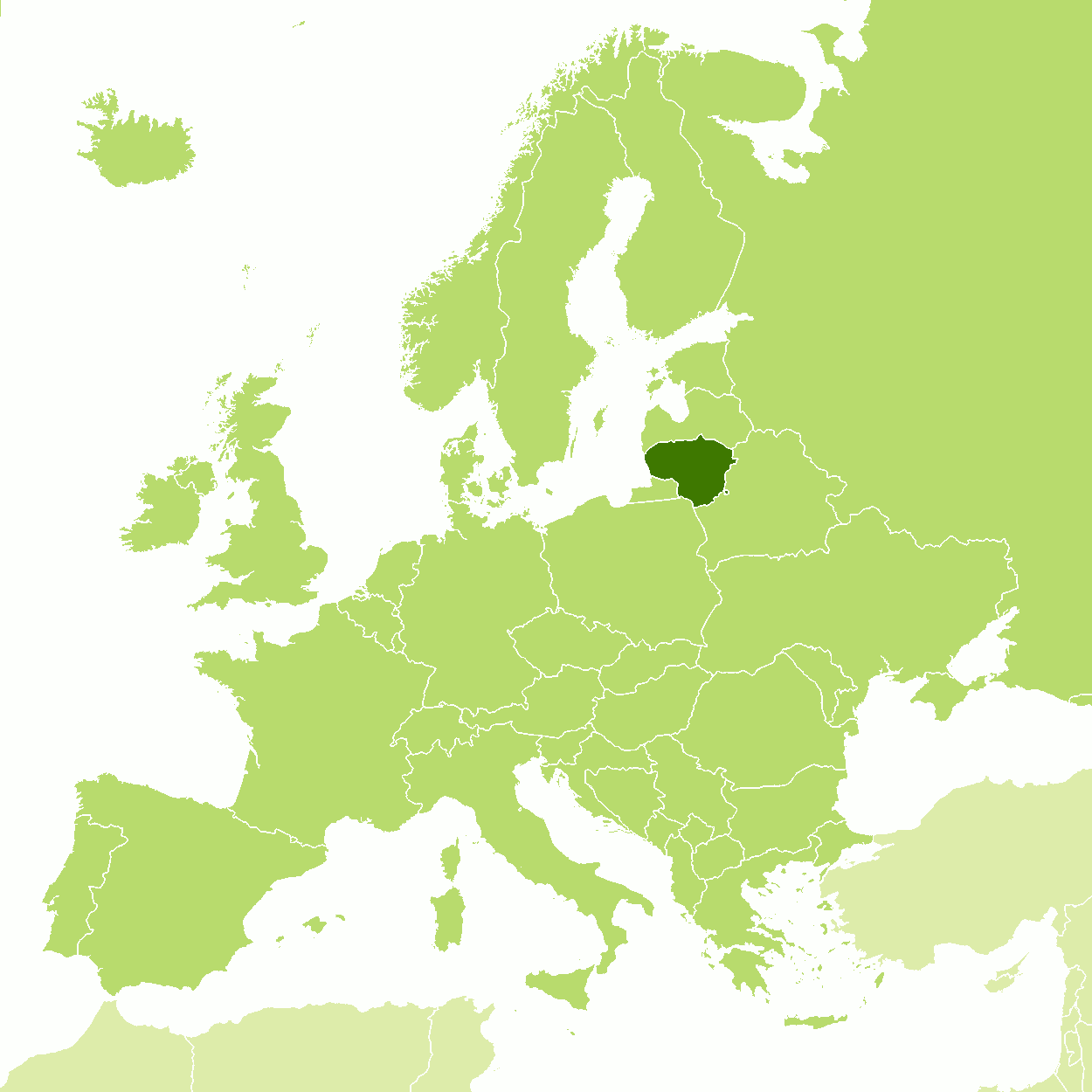The Climate of
Lithuania
 Town Hall Square, Vilnius
Town Hall Square, Vilnius
Climate Map
 Climate map of Lithuania
Climate map of Lithuania
What is the climate of Lithuania like?
Lithuania is situated in northern Europe on the eastern coast of the Baltic Sea. It borders Latvia to the north, Belarus to the south and east, and Poland and the Kaliningrad region of Russia to the southwest.
Lithuania’s climate is transitional between maritime and continental, and considerable temperature variations are experienced. Summer is warm with the heaviest rainfall often occuring in July or August. Lithuania’s proximity to the Baltic Sea provides a moderating maritime influence enabling mild winters and cool summers. In the east, however, conditions may vary from this pattern. Winter can be very cold and is dominated by cold winds from the interior of Russia. In January, temperatures average −3°C (27°F). In summer, temperatures average 18°C (64°F).
Western Lithuania receives more rain than the rest of the country, with an average annual precipitation in Klaipėda of 850 millimeters (33 inches), compared to 650 millimeters (25 inches) in Vilnius in the east. The growing season lasts 200 days in the western part of the country and 170 days in the eastern part.
| Climate data for Klaipėda (1991-2020) | |||||||||||||
|---|---|---|---|---|---|---|---|---|---|---|---|---|---|
| Month | Jan | Feb | Mar | Apr | May | Jun | Jul | Aug | Sep | Oct | Nov | Dec | Year |
| Average high °C (°F) | 1.3 (34.3) | 1.3 (34.3) | 4.5 (40.1) | 10.8 (51.4) | 16.0 (60.8) | 19.3 (66.7) | 22.1 (71.8) | 22.3 (72.1) | 17.8 (64.0) | 11.9 (53.4) | 6.3 (43.3) | 3.2 (37.8) | 11.6 (52.9) |
| Daily mean °C (°F) | −0.7 (30.7) | −0.9 (30.4) | 1.8 (35.2) | 7.1 (44.8) | 11.8 (53.2) | 15.5 (59.9) | 18.4 (65.1) | 18.5 (65.3) | 14.3 (57.7) | 9.0 (48.2) | 4.2 (39.6) | 1.2 (34.2) | 8.5 (47.3) |
| Average low °C (°F) | −2.9 (26.8) | −3.1 (26.4) | −1.0 (30.2) | 3.1 (37.6) | 7.5 (45.5) | 11.6 (52.9) | 14.7 (58.5) | 14.6 (58.3) | 10.8 (51.4) | 6.2 (43.2) | 2.3 (36.1) | −0.8 (30.6) | 5.3 (41.5) |
| Average precipitation mm (inches) | 73.4 (2.89) | 50.7 (2.00) | 47.1 (1.85) | 36.2 (1.43) | 43.7 (1.72) | 59.7 (2.35) | 74.1 (2.92) | 96.8 (3.81) | 89.5 (3.52) | 108.3 (4.26) | 90.1 (3.55) | 79.9 (3.15) | 853.1 (33.59) |
| Source: Météo Climat | |||||||||||||
| Climate data for Vilnius (1991–2020) | |||||||||||||
|---|---|---|---|---|---|---|---|---|---|---|---|---|---|
| Month | Jan | Feb | Mar | Apr | May | Jun | Jul | Aug | Sep | Oct | Nov | Dec | Year |
| Average high °C (°F) | −1.7 (28.9) | −0.5 (31.1) | 4.4 (39.9) | 12.6 (54.7) | 18.4 (65.1) | 21.7 (71.1) | 23.8 (74.8) | 23.1 (73.6) | 17.4 (63.3) | 10.2 (50.4) | 3.7 (38.7) | −0.3 (31.5) | 11.2 (52.2) |
| Daily mean °C (°F) | −3.9 (25.0) | −3.1 (26.4) | 0.9 (33.6) | 7.6 (45.7) | 13.0 (55.4) | 16.4 (61.5) | 18.7 (65.7) | 17.9 (64.2) | 13.0 (55.4) | 7.0 (44.6) | 1.8 (35.2) | −2.2 (28.0) | 7.3 (45.1) |
| Average low °C (°F) | −5.9 (21.4) | −5.6 (21.9) | −2.7 (27.1) | 2.6 (36.7) | 7.5 (45.5) | 11.1 (52.0) | 13.6 (56.5) | 12.7 (54.9) | 8.5 (47.3) | 3.7 (38.7) | −0.1 (31.8) | −4.1 (24.6) | 3.5 (38.3) |
| Average precipitation mm (inches) | 38.9 (1.53) | 34.4 (1.35) | 37.0 (1.46) | 46.2 (1.82) | 52.1 (2.05) | 72.7 (2.86) | 79.3 (3.12) | 75.8 (2.98) | 65.2 (2.57) | 51.5 (2.03) | 51.5 (2.03) | 49.2 (1.94) | 653.8 (25.74) |
| Source: World Meteorological Organization | |||||||||||||
References
- E. A. Pearce, Charles Gordon Smith, (1990) The Hutchinson World Weather Guide, John Murray Press. ISBN 1859863426
- Timothy L. Gall, (ed.), (2003), Worldmark Encyclopedia of the Nations, Eleventh Edition, Thomson Gale
- Federal Research Division, Library of Congress, (1996), Estonia, Latvia & Lithuania: country studies. Claitor's Pub. Division. ISBN 0844408514
- Hugh Chisholm, (ed.), (1911), Encyclopædia Britannica, Eleventh edition, Cambridge University Press
The Climate of
Lithuania

In summary:
Lithuania's climate is transitional between maritime and continental. Winter can be very cold when there cold winds from the interior of Russia. Summers are warm: the mean temperature in July is 18°C (64°F).
Rainfall averages from 500 mm (25 in) to 850 mm (33 in) depending on location.